Guide to Locating Meteorites: Techniques and Insights


Intro
Meteorite hunting isn't just a hobby; it's a journey through time and space. With every search, you're not just looking for a rock; you're digging up fragments of the universe's history. Some say that when you hold a meteorite, you're holding a piece of the cosmos right in your hand. The thrill of finding one of these celestial treasures propels many enthusiasts into the great outdoors, armed with nothing but curiosity and a sense of adventure.
As the enthusiasm for collecting and studying meteorites grows, it's essential to delve into the various dimensions of this activity. In this guide, we will explore the types of meteorites that exist, the equipment necessary for effective hunting, and the legal frameworks surrounding their collection. Whether you are an amateur collector or a seasoned enthusiast looking to expand your knowledge, this resource is tailored just for you. We aim to elucidate every point, providing practical techniques and valuable tips along the way.
So buckle up, as we embark on this fascinating quest to uncover the art and science of finding meteorites. Let's take a closer look at what makes this pursuit so captivating, beginning with our Featured Collectible of the Month, a unique specimen that embodies the allure of meteorite hunting.
Featured Collectible of the Month
Overview
This month, we spotlight the Allende meteorite, which fell in Chihuahua, Mexico in 1969. Known for its distinctive appearance and rich scientific significance, the Allende meteorite has become a favorite among collectors. This particular meteorite is classified as a carbonaceous chondrite, a rare type that provides invaluable insights into the early solar system.
Historical Significance
The Allende meteorite is not merely a rock; it is a time capsule that allows scientists to study the conditions that prevailed during the solar system's formation. With surrounding gas and dust, it showcases primordial materials that predate our planet. Interest in this meteorite surged not only due to its age but also because of the wealth of organic compounds it contains, paving new pathways for research in astrobiology. Collectors treasure it for its unique story, making it a sought-after addition to any serious collection.
"Every meteorite tells a story; the Allende just happens to be a bestseller."
Identification Techniques
Identifying a meteorite from terrestrial rocks can be a tricky business, especially for beginners. Familiarizing oneself with a few identification techniques can enhance your chances of spotting genuine cosmic samples.
Visual Characteristics
- Fusion crust: A thin, darkened layer that forms when a meteorite enters the Earth's atmosphere.
- Metallic flecks: Often made of nickel-iron, these small shiny spots indicate an iron-rich meteorite.
- Chondrules: These round grains often found in chondrites can help in identification, hinting at the meteorite's origin.
Resources for Identification
To aid in identifying meteorites, it helps to consult specialized resources:
- Wikipedia on Meteorites
- Britannica's Overview
- Meteorite identification forums on Reddit
By diving into resources like these, aspiring meteorite hunters can refine their search skills, boosting their confidence as they tread through fields and deserts. Though it may seem daunting, with practice and keen observation, anyone can find their own little piece of the universe.
Understanding Meteorites
Understanding meteorites is not just about marveling at the beauty of these celestial remnants; it’s about grasping their significance in both scientific and cultural contexts. Meteorites serve as time capsules, offering glimpses into the earliest moments of the solar system. By comprehending what meteorites are and how they are classified, enthusiasts and collectors can better appreciate their value, not only as collectibles but also as tools for scientific discovery.
Definition and Classification
Chondrites
Chondrites are perhaps the most abundant meteorites, making up about 86% of all falls. They are characterized by the presence of chondrules—small, round grains made of minerals. These meteorites are often seen as the building blocks of planets, providing essential insights into solar system formation. A key characteristic of chondrites is their primitive composition; they haven’t evolved much since they formed around 4.6 billion years ago. This ancient lineage makes them a popular choice for those who want to connect with the origins of our celestial neighborhood.
However, their very beauty can be a double-edged sword. Many collectors tout chondrites for their diversity and range, but identifying them can be tricky without proper knowledge. An advantage of collecting chondrites is that they often come at a lower price point compared to rarer types.
Achondrites
Achondrites are known for their lack of chondrules, and instead, they are formed from differentiated parent bodies that have undergone some degree of geological activity. Their composition can vary greatly, often resembling terrestrial rocks. This characteristic gives achondrites a unique scientific value; they help researchers understand how bodies in the solar system can evolve.
Collectors often find achondrites appealing due to their distinctive appearances, and they can serve as excellent conversation starters. However, finding authentic examples can be a challenge, as many fakes exist. This means that while they are a compelling addition to a collection, due diligence is essential when acquiring them.
Iron Meteorites
Iron meteorites, as the name suggests, are primarily composed of iron and nickel. They are less common than stony meteorites but are well loved for their unique features and striking appearances. The key characteristic of iron meteorites is their metallic luster, which often leads to a stunning polished surface when treated correctly. Many collectors appreciate these pieces for their historical significance as well, given that many were used by ancient peoples to craft tools.
The challenge here is twofold: first, iron meteorites can be heavy, making them less portable, and second, the demand for these types can inflate prices. Still, for the enthusiastic collector, possessing an iron meteorite feels like holding a piece of solar history.
Stony-Iron Meteorites
Stony-iron meteorites combine both metal and stone, which can offer a fascinating aesthetic contrast. This category includes beautiful specimens like pallasites, which are known for their mesmerizing olivine crystals surrounded by a nickel-iron matrix. The dual nature of these meteorites makes them a distinct choice for collectors looking for something out of the ordinary.
While they can be quite rare and occasionally pricey, stony-iron meteorites present a unique opportunity to explore a hybrid of properties. Their distinctiveness often sparks deeper interest in the geological processes at play both on their parent bodies and Earth. Still, collectors must be cautious as the rarity also opens avenues for fraud.
The Importance of Meteorites
Meteorites carry important messages from the cosmos, and examining their importance can greatly enhance one’s appreciation of the field.
Scientific Value
The scientific value of meteorites is immense. They provide crucial information about the formation of the solar system, planetary processes, and even the conditions that existed during the early history of the Earth. For researchers, each meteorite can potentially hold the key to understanding cosmic history and offers invaluable data for numerous fields such as astronomy, geology, and even climatology.
However, access to rare samples and the authenticity of findings can pose challenges, particularly for amateur enthusiasts.
Cultural Significance
Looking beyond the scientific lenses, meteorites have often played significant roles in various cultures across history. Some societies revered meteorites, considering them sacred objects or omens. This cultural significance often intersects with national pride, as certain countries may boast their own meteorite finds. For collectors, understanding this cultural narrative can deepen the enjoyment of their acquisitions—these rocks tell stories that transcend their physical form.
Historical Context
Meteorites have consistently captured human imagination, influencing history and inspiring exploration and discovery. The historical context surrounding meteorites can reveal much about human aspirations, collection practices, and even the development of early science. As meteoric phenomena often fall under folklore, studying these narratives can open up fascinating windows into the past.
As you delve further into this guide, remember that the stories behind meteorites are just as important as the specimens themselves. Each piece embodies knowledge waiting to be discovered.
Preparing for the Search
Preparing for the search is an essential step in meteorite hunting. A successful expedition hinges on proper planning, and this section will guide you through the nitty-gritty of what to consider before setting foot on potentially fruitful grounds. Knowing where to go and what to bring not only increases your chances of finding meteorites but also ensures that you are ready for a variety of conditions you may face out in the field.
Researching Potential Locations
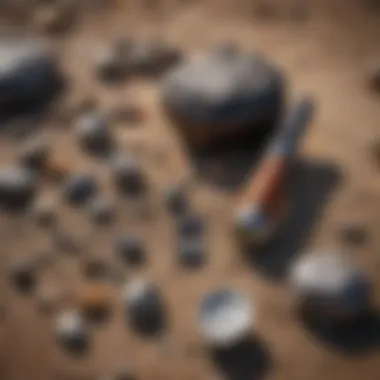
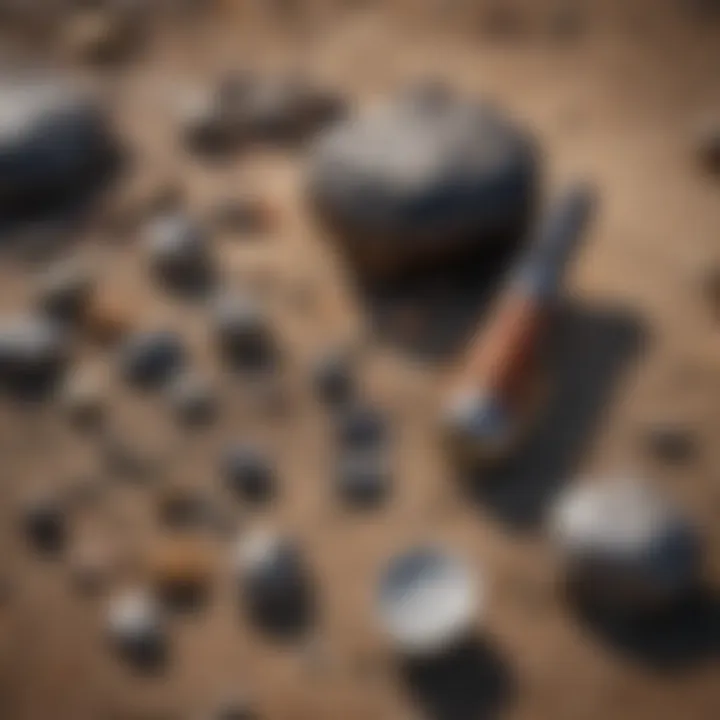
Famous Meteorite Falls
When it comes to locating meteorites, targeting famous meteorite falls is a prime strategy. These locations are notorious among hunters, often yielding many fascinating findings. For instance, places like the Campo del Cielo in Argentina stand out. Here, you can discover significant iron meteorites, some weighing in at a hefty 37 tons. The abundance of meteorites in such areas stems from past falls, which deposited these celestial stones over a wide radius, creating a potential goldmine for collectors.
Another notable example is the Sikhote-Alin, located in Russia. This area had one of the largest meteorite falls in history back in 1947, with pieces scattered over miles. Such historical significance not only boosts the possibility of finding meteorites but adds a rich backstory to your discovery.
However, competition can be fierce in these well-known spots. Many seasoned meteorite hunters frequent these sites, making it challenging for newcomers to find their own unique finds. Each location does present its own set of advantages and challenges, requiring experience and sometimes a bit of luck.
Geological Features to Consider
Understanding the geological features of a potential hunting location is equally important. Certain landscapes are undeniably more favorable for meteorite hunting. For example, areas with sandy soils often provide a better backdrop for spotting meteorites as they tend to stand out against lighter colors. Likewise, rocky areas can also be bountiful, especially if they have cliffs or outcrops where meteorites may have eroded from.
When you talk about unique landscapes, consider how volcanic regions can offer surprising finds. The high-density features of lava fields might seem inhospitable but can often reveal meteorites that have come into contact with volcanic debris. They often become hidden within the rocks, waiting to be discovered by attentive eyes.
Being aware of these geological characteristics can make your search more effective. However, some terrains may also present hazards, whether it be harsh weather conditions or the need for specialized equipment to navigate or excavate safely.
Essential Equipment
Metal Detectors
Metal detectors are arguably a game-changer for aspiring meteorite hunters. They can efficiently locate metallic objects buried beneath the surface, making it easier to find iron meteorites that have often sunk into the ground. With proper calibration, these detectors not only allow you to unearth treasures but can also prevent hours of fruitless digging. However, it’s worth mentioning that they can be pricy, requiring a solid understanding of how to use them effectively.
Another aspect to keep in mind is your choice of detector; some are better suited for different terrains than others. For example, a multi-frequency model might serve well in diverse locations but can be overwhelming for beginners.
Magnifying Glasses
A magnifying glass is a handy tool that should never be overlooked. Its ability to enlarge the minute details of a meteorite can be indispensable, especially when analyzing surface texture or features. This small piece of equipment becomes a crucial ally in the field, allowing you to distinguish between a meteorite and common stones.
However, relying solely on a magnifying glass may limit your vision. It’s best used in conjunction with other tools for a comprehensive assessment of your finds.
Field Notebooks
Field notebooks might seem mundane, but they’re vital in recording your observations. Documenting locations, weather conditions, and any notable finds can aid in tracking patterns in meteorite falls or individual hunting experiences. An organized record can eventually help motivate future searches by identifying locations that yielded great results before.
As simple as it sounds, having a notebook handy can prevent critical information from slipping through the cracks. Writing down your thoughts, sketches, or findings is also beneficial for memory retention, something that can be crucial when you finally attend meteorite shows or meet-ups with fellow enthusiasts, where you're expected to share what you've learned.
Camera Equipment
Lastly, a thoughtful meteorite hunter would be wise to pack camera equipment. Not only for capturing the moments of your adventure but also to document your finds. Photographs are useful for cataloging items after your search, helping you maintain your collection, or even for sharing in community forums.
The beauty of photography lies in its ability to provide a reference for comparisons later. For example, taking a close-up shot of a newly discovered meteorite can serve as a record of surface characteristics—important for proper identification and sharing with other collectors. However, the gear needed can get bulky, making it key to balance the equipment you bring so as not to become overly encumbered while searching.
In summary, being well-prepared for a meteorite hunt significantly enhances your chances of making remarkable finds while ensuring that the experience is both enjoyable and fruitful. Understanding potential locations and having the right tools makes the difference, and those few extra moments spent in preparation can pay off in spades.
Field Techniques for Finding Meteorites
When it comes to locating meteorites, one doesn't want to just wander aimlessly in pursuit of a celestial souvenir. Field techniques are essential; they not only improve the chances of discovery but also help save time and resources. These methods provide structure to the search, allowing aspiring enthusiasts to maximize their effort and return home with not just stories, but tangible finds.
Best Practices in the Field
Mapping Strategies
Effective mapping strategies are often the cornerstone of any successful meteorite hunting expedition. Most seasoned hunters would agree that knowledge is power. A map not only outlines the terrain but also highlights potential locations where meteorites are likely to be found, based on historical data and geological features. Key characteristic here is the detailed approach one can take; studies from previous meteorite falls can guide you where to dig in.
Unique feature of mapping strategies is the ability to overlay various geological maps and satellite imagery to pinpoint exact locations. The advantage? You can potentially target areas that have higher probabilities of finding meteorites, rather than just following the wind.
Survey Methods
Survey methods are integral for methodical exploration. Enthusiasts often adopt systematic approaches such as grid search patterns or transect surveys. What’s beneficial about these methods is they allow for thorough examination of an area, leaving no stone unturned. By utilizing this technique, a hunter can cover significant ground efficiently, often leading to unexpected finds.
A unique feature in employing survey methods is the employment of both visual scanning and technology—like metal detectors. While technology has its upsides, it can sometimes miss smaller meteorites. Thus, a combined approach is often the best path forward.
Recording Finds
Once something of interest is discovered, recording finds becomes paramount. This isn’t just an act of keeping track; it enriches the overall hunt with critical data. Notably, keeping a log of observations adds scientific value to your collection. Key aspect of recording is to document everything: location, date, and an accurate description of your find.
An interesting advantage of this is that when shared with fellow enthusiasts or researchers, it contributes to collective knowledge in the meteorite community. On the flip side, it can be seen as tedious work, but the benefits it brings, both personally and collectively, often outweighs the downsides.
Adapting to Different Environments
Finding meteorites isn't a uniform experience; different environments present their unique challenges and opportunities for discovery. The ability to adapt your techniques based on the setting can mean the difference between finding trailing dust and actually landing a gem.
Desert Searches
Desert searches are often highlighted as prime hunting grounds. The clear skies and sparse vegetation allow for excellent visibility which can make spotting meteorites a tad easier. The key characteristic of these searches is the open landscape, typically providing the opportunity for long-range sighting.
However, one has to be mindful of the harsh environmental conditions such as extreme heat. This means adequate preparation is essential. Yet, the benefit is that you can frequently find meteorites on the surface due to erosion, as there's little vegetation to obscure them.
Forest and Terrain Challenges
While forests seem rich with potential, they can also prove to be formidable foes. The dense vegetation creates obstacles that can hinder visibility and complicate the search. Yet, this is where hunters often need to think outside the box and consider key characteristics such as timing: hunting right after a storm can reveal finds dislodged from their resting places.
The unique difficulty here comes not only from visibility but also navigation through difficult terrain. On the bright side, the thick foliage offers excellent hiding spots for meteorites, hence persistence often pays off.
Urban Areas
Urban areas present a different challenge altogether. The noise and bustling activity of city life can overshadow the quiet contemplation often required for serious hunting. However, disregarding urban landscapes entirely is a mistake. One benefit of these settings is the human activity—people can unknowingly unearthed meteorites during construction or gardening.
Yet, the downside includes legal restrictions on collecting items in public spaces, complicating a city slicker’s hunt. Therefore, balancing enthusiasm with local regulations is crucial to a successful urban search.
Legal and Ethical Considerations
When embarking on a journey to find meteorites, understanding the legal and ethical considerations becomes paramount. These aspects shape the framework within which collectors must navigate. Ignoring them could lead to potential fines, loss of specimens, or worse yet, create a negative impact on the natural environment. Knowing the laws and ethical best practices is not just good for the hobbyist’s soul; it also contributes to the overall preservation of these celestial treasures for future generations.
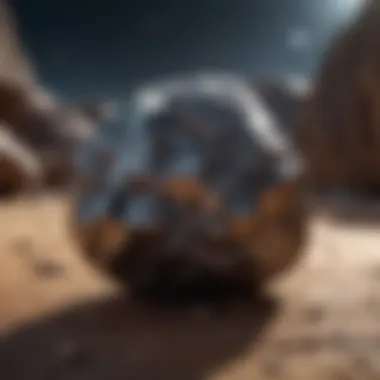

Ownership Laws
Ownership laws play a crucial role in determining the legality of meteorite hunting, which can vary significantly from one region to another.
Federal Regulations
Federal regulations often provide a broad outline for meteorite ownership. The U.S. government maintains rights over meteorites found on federal land. Generally speaking, any meteorite discovered in such areas is considered government property, and collectors need to acquire a permit for collection. This characteristic makes federal regulations a well-structured yet somewhat restrictive option for enthusiasts looking to collect meteorites. The benefit here is straightforward: it prevents widespread exploitation and preserves the scientific value of meteorites that may be of particular interest. However, the downside is that it makes the search process far more complicated for collectors operating in certain areas.
State Laws
State laws further complicate the meteorite hunting landscape, as they can differ widely even within the same country. Each state has its regulations concerning meteorite ownership, which may allow for more lenient collection approaches, but also imposes restrictions depending on the land type. For example, collectors may have more freedom on private land compared to public areas. A key characteristic of state laws is that they may promote local heritage, emphasizing the importance of understanding one’s region. Still, the downside is the fragmented nature of these laws, making it difficult for hunters to know exactly what rules apply where.
Ethical Searching Practices
Beyond legality, ethical searching practices underscore a collector's responsibility to engage sustainably with nature and respect meteorite origins.
Sustainable Collecting
Sustainable collecting emphasizes the need for collectors to limit environmental impact. This approach calls for taking only what is necessary and leaving the site as undisturbed as possible. The benefit of sustainable collecting is twofold: it encourages conservation efforts while fostering good relationships between collectors and local communities. What sets sustainable collecting apart is the focus on education and responsibility, which paves the way for future generations to share in the joy of discovery. On the contrary, there's the risk of not adhering strictly to these principles could lead to over-collection and potentially harm the delicate ecosystems in which these treasures reside.
Respecting Natural Areas
Respecting natural areas is an ethical cornerstone that goes hand-in-hand with responsible collecting. Being mindful of the terrain, native species, and distinct geological features during hunts not only preserves site integrity but also encourages harmony between collectors and nature. This ethical approach makes a notable contribution to conservation efforts, as it promotes awareness of the ecological balance and the delicate interdependence of life. The unique feature of this practice is its advocacy for stewardship—viewing oneself as a custodian of nature, rather than merely a collector. However, neglect in this area could lead to irreversible damage, thus compromising the very environments that offer a sense of wonder and discovery.
Identifying Meteorites
Identifying meteorites is a crucial step for anyone venturing into the exciting world of meteorite hunting. Understanding how to distinguish these celestial rocks from the myriad of terrestrial stones can make or break a successful search. Meteorites not only hold scientific value but they also carry cultural significance, offering a glimpse into our solar system's history. By focusing on specific physical characteristics and employing effective field tests, enthusiasts can enhance their skills in identifying meteorites with greater accuracy and confidence.
Physical Characteristics
Surface Texture
Surface texture is one of the most noticeable physical characteristics that can help identify a meteorite. Most meteorites feature a unique texture that is unlike typical earth rocks. They often exhibit a matte finish, showcasing a fusion crust that forms as they enter the Earth's atmosphere. This crust can range from smooth to rough, depending on how long the meteorite spent in the atmosphere.
- A key characteristic of surface texture is its ability to reveal weathering effects, where earthly conditions can alter the appearance of meteorites over time.
- This contrasts sharply with mundane rocks that usually show signs of erosion.
- The distinct quality of a meteorite's surface texture serves as a beneficial guideline for hunters, helping them narrow down their search within any given location. However, it's worth noting that some terrestrial rocks can mimic this feature, making careful observation essential.
Weight and Density
Weight and density are fundamental aspects in meteorite identification. Meteorites often have higher densities compared to regular rocks, mainly due to their metallic content. When holding a suspected meteorite, a collector might notice that it feels unusually heavy for its size. This is often a direct indication that one might be dealing with a genuine find.
- The key characteristic here is that meteorites typically weigh more because of elements like iron and nickel.
- A notable benefit of this physical feature is that it offers an immediate, tactile means of differentiation.
- On the flip side, weight alone shouldn't be the sole determining factor, as some local stones may also be dense due to mineral composition. So, this characteristic must be combined with other methods for better accuracy.
Magnetism
Magnetism plays a significant role in identifying meteorites as many contain iron that can react strongly to a magnet. A quick test with a magnet can reveal whether a rock is a candidate for being a meteorite or just another ordinary stone.
- The essential characteristic of magnetism in meteorites is its reliability; a significant number of them will exhibit magnetic properties due to their metallic components.
- For collectors who are just starting out, using a simple magnet can be a less technical yet effective way to filter potential finds.
- Yet, magnetism can also lead to confusion since some earthly rocks also carry iron, sometimes necessitating additional verification to avoid misidentification.
Field Tests
Visual Identification Techniques
Visual identification techniques are foundational in the preliminary analysis of suspected meteorites. By closely examining the surface features, anyone can sometimes spot the telltale signs that distinguish meteorites from terrestrial rocks. This can involve scrutinizing for the aforementioned unique surface texture and any signs of fusion crust, as well as looking for conclusive color variations that suggest a cosmic origin.
- The key aspect of using visual identification is that it’s cost-effective and requires no special tools—great for beginners.
- Collectors often find this approach rewarding as they learn to recognize specific features more intuitively over time.
- Nevertheless, it's important to be cautious; numerous earth rocks can display similar appearances, leading to possible misidentifications.
Chemical Tests
Chemical tests can provide definitive proof when identifying meteorites. They often involve assessing the elemental composition of a suspected find, checking for specific minerals and isotopes that are characteristic of meteorites – notably, the presence of nickel and certain atypical minerals that are rare on Earth.
- A significant advantage of chemical tests is their rigorous nature, offering a scientific basis for confirmation.
- Advanced collectors or researchers often appreciate this method as it delivers clarity on the find's classification.
- On the downside, chemical tests can require equipment and expertise that may not be readily available to casual collectors. Thus, these tests are usually supplementary, rather than the first step, in the identification process.
In summary, effectively identifying meteorites demands a good grasp of their physical characteristics and the application of both visual and chemical tests. With practice, anyone can enhance their skills and confidence in making discoveries that are out of this world!
Preservation and Care
Taking care of meteorite finds is not just about keeping them pretty; it's about safeguarding a piece of cosmic history. When you discover a meteorite, you're holding an ancient artifact that can provide insights into the formation of our solar system. Proper preservation and care ensure that these rocks maintain their scientific, emotional, and monetary value.
Cleaning Meteorite Finds
Techniques for Different Types
Cleaning techniques vary significantly depending on the type of meteorite. For example, chondrites often require gentle cleaning with distilled water and soft brushes to avoid damaging their fragile surfaces. Conversely, iron meteorites can handle more aggressive methods, such as using a mild acid to remove rust. Choosing the right technique is key.
- Benefits:
- Unique trait: Proper cleaning methods can spotlight unique features of the meteorite, such as its crystalline structure or inclusions.
- Maintains the meteorite’s original characteristics.
- Enhances visual appeal, which can be important for collectors or displays.
However, be cautious. Overzealous cleaning can lead to loss of patina or other important identifiers which can detriment scientific value.
Avoiding Damage
The aspect of avoiding damage is crucial for meteorite hunters. Even the tiniest slip can lead to scratches or breaks in a meteorite’s structure. One characteristic of avoiding damage is using soft, lint-free cloths and ensuring that any tools used are non-abrasive.
- Benefits:
- Unique feature: The insight offered by damage-free specimens can lead to better analysis, aiding everything from personal understanding to professional scientific study.
- Protects historical integrity of the find.
- Preserves the scientific potential of the meteorite.
Failing to consider protection techniques can lead to irreversible damage. Understanding how to handle and clean meteorites is vital for any collector.
Storage Recommendations
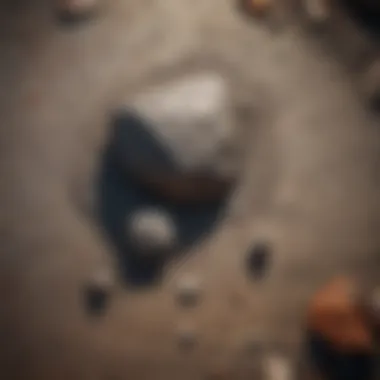
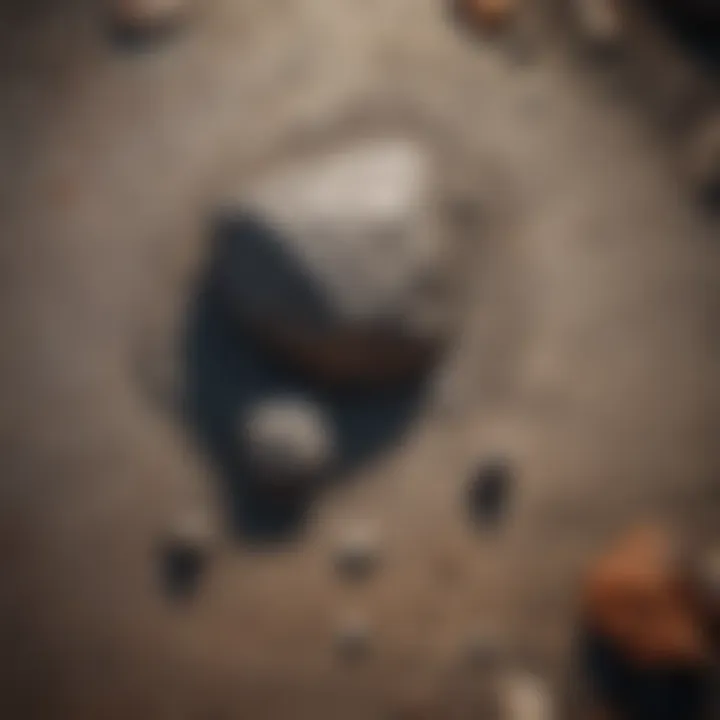
Proper storage is equally as important as cleaning. The conditions in which a meteorite is stored can drastically affect its preservation. Environments that are too humid can lead to rust, especially for iron meteorites, while dry conditions may cause the meteorite to crack.
Display Cases
Display cases serve not just as a method of presentation but also as a form of protection. Choosing display cases that are made from UV-resistant glass helps prevent deterioration caused by sunlight, while secure fastening methods can deter physical damage.
- Benefits:
- Unique aspect: Carefully designed display cases can allow collectors to show off their specimens while keeping them safe from dust and accidental impacts.
- Creates a safe viewing environment.
- Enhances visual interest in a collection.
Environmental Considerations
Considering the environment is crucial in preserving meteorites. Factors like temperature fluctuations, humidity, and exposure to sunlight can degrade the integrity of these space rocks.
- Benefits:
- Unique feature: Utilizing silica gel packets or other humidity controls can help maintain consistency in even disastrous conditions.
- Ensures a stable living condition for meteorites.
- Reduces the chances of chemical reactions that may occur with unstable surroundings.
This foundational understanding of preserving and caring for meteorites goes beyond mere storage. It embodies responsibility, respect, and love for pieces of our cosmic heritage.
The Community of Meteorite Hunters
The realm of meteorite hunting is not just about solitary searches and individual finds; it thrives on a robust community of enthusiasts, collectors, and scholars. This community serves multiple important functions: sharing knowledge, supporting one another in the field, and fostering a culture of respect and appreciation for meteorites. Being part of this community can enhance your experience and your understanding of the field.
Connecting with Other Enthusiasts
The thrill of finding a meteorite can be exhilarating, but sharing that joy with others makes it even sweeter. Connecting with fellow hunters can significantly enrich the experience.
Online Forums
Online forums provide a platform for meteorite hunters to gather and exchange information. One of the key characteristics of these forums is their accessibility. They allow enthusiasts from all corners of the globe to share experiences, tips, and photos of their finds. Platforms like Reddit even have dedicated sections where users discuss meteorites, making it easy to tap into a wealth of knowledge at your fingertips.
The unique feature of online forums lies in their immediacy. Whether you're seeking identification help or looking for advice on a specific location, you can receive rapid feedback from seasoned hunters.
However, a disadvantage can be the variance in expertise levels—information shared might not always be accurate. Therefore, it’s crucial to cross-reference what you learn online. Still, the advantages far outweigh the drawbacks, as these forums often help beginners find their footing in the world of meteorite hunting.
Local Clubs
Local clubs provide a face-to-face opportunity for meteorite enthusiasts to connect. This direct interaction fosters a sense of camaraderie that online forums can’t replicate. Joining a club can be a beneficial choice for anyone serious about pursuing meteorite hunting. Clubs often organize field trips, lectures, and workshops, enabling hands-on learning and the sharing of finds in person.
A unique aspect of local clubs is the range of expertise participants bring. From novices to experts, interaction within these groups allows for diverse perspectives and shared experiences that can help elevate one’s skills.
However, membership might require time commitment and some might not have clubs nearby, but the benefits of in-person engagement and networking are invaluable for many enthusiasts.
Sharing Finds and Knowledge
Beyond connecting with fellow hunters, sharing your finds is an integral part of being a meteorite enthusiast. It promotes not only personal growth but also contributes to the broader understanding of meteorites.
Publications
Contributing to publications, whether in magazines or academic journals, allows hunters to share their discoveries and insights. This is an effective way to showcase knowledge and contribute to scientific discourse.
The primary characteristic of these publications is their formality. Many meteorite enthusiasts find writing about their experiences rewarding, as it can lead to acknowledgment within the community. Plus, it archives discoveries for future reference.
While the process might seem daunting and requires a certain level of writing skill, the advantages of documenting and sharing knowledge can play an important role in advancing your reputation as an expert in the field.
Conferences
Attending conferences dedicated to meteorites offers another unique opportunity for learning and networking. These events gather like-minded individuals, researchers, and collectors in one space.
Conferences often feature talks from leading experts in the field, providing attendees with insights into the latest research and developments. This environment encourages discussions that can spark new ideas or collaborations.
However, attending conferences can come with costs, such as registration fees and travel expenses. While this may deter some, the value of face-to-face interaction and the wealth of information available makes it a worthwhile endeavor for many involved in meteorite hunting.
Engaging with the community of meteorite hunters opens doors to learning and sharing in ways solitary hunts cannot achieve.
The Future of Meteorite Hunting
The future of meteorite hunting is looking brighter than a shooting star on a clear night. With the advancement of technology and an expanding community of enthusiastic researchers, we are witnessing a notable evolution in the ways enthusiasts can locate and study these fascinating celestial objects. This section focuses on important elements of meteorite hunting as it shifts into the future, emphasizing technological strides and the role of citizen science.
Technological Advances
Enhanced Detection Equipment
When it comes to detecting meteorites, the specific aspect of enhanced detection equipment cannot be overlooked. This equipment has revolutionized the way people search for meteorites, making it more efficient and accurate than ever before. One of the key characteristics of enhanced detection equipment is its ability to locate small metallic fragments that might otherwise go unnoticed. This is a beneficial choice for both amateurs and seasoned hunters, as it increases the likelihood of finding meteorites in previously explored areas.
A unique feature of this equipment is the integration of GPS technology, allowing hunters to mark precise locations of their finds. This can be an advantage when revisiting areas for future searches or cataloging discoveries. However, the high cost of some detection devices can be a disadvantage for casual enthusiasts looking to dive into meteorite hunting without a hefty investment.
Remote Sensing Techniques
Remote sensing techniques are another significant innovation in meteorite hunting. These methods employ satellite imagery, aerial photography, and drones to survey vast areas that might hold meteorites. The key characteristic of this approach is its ability to cover large terrains quickly, which is especially useful when exploring remote or rugged landscapes. It represents a popular choice for meteorite enthusiasts who wish to broaden their search area without physically traversing potentially harsh environments.
The unique feature of remote sensing is its capability to analyze geological formations that can indicate potential meteorite impact sites. This advantage allows researchers to identify hotspots for meteorite recovery more accurately. On the flip side, the reliance on technology can sometimes limit hands-on experience, as hunters may not engage fully with the environment.
The Role of Citizen Science
Collaborative Research Projects
Citizen science has transformed how meteorite hunting is conducted by involving non-professionals in collaborative research projects. This aspect enhances the overall goal of expanding knowledge about meteorites through collective effort. A key characteristic of these projects is their ability to gather vast amounts of data from diverse sources, increasing the potential for significant discoveries.
Collaborative research projects are especially valuable as they link amateur hunters with professional scientists. This relationship can lead to a variety of opportunities, such as participation in specialized fieldwork and data analysis training. However, the coordination of volunteers can sometimes present challenges in terms of communication and organization, which requires strong leadership to ensure collaborative efforts run smoothly.
Data Sharing Initiatives
Another pivotal aspect of citizen science in meteorite hunting is the creation of data sharing initiatives. These platforms allow enthusiasts to share findings, observations, and even photographs of their meteorite discoveries. One key characteristic of these initiatives is their ability to foster a sense of community among collectors and researchers. This approach benefits the broader scientific community by accumulating a wealth of knowledge and examples from different geographical regions.
A unique feature of data sharing initiatives is the ability for amateur hunters to contribute data that may enhance ongoing scientific quests and publications. While such platforms are a fantastic tool for building connections, they can sometimes be overwhelming if not well organized. Notably, the quality of the shared data can vary, necessitating some degree of verification to maintain accuracy.
In summary, the future of meteorite hunting is charged with potential from technological advancements and the vibrant contributions of citizen scientists. As the community continues to grow, so too does the opportunity for every aspiring collector to encounter the wonders of the cosmos.



